Choosing the best organizational structure for your company, division, or team is a lot like picking out a new car.
At the most basic level, you're always looking for something road-worthy -- something that can take you (and your passengers) from point A to point B without a hitch.But beyond that, there are a lot of options to consider. Automatic or manual? Four-wheel drive or two? Built-in GPS? Leather interior? Flux capacitor? (Only if you're going back in time, of course.)
In the world of organizational structures, the options you have to choose from include things like chain of command (long or short?), span of control (wide or narrow?), and centralization (centralized or decentralized decision-making?), just to name a few.
Organizational Structure
An organizational structure is a visual diagram of a company that describes what employees do, whom they report to, and how decisions are made across the business. Organizational structures can use functions, markets, products, geographies, or processes as their guide, and cater to businesses of specific sizes and industries.
What's the point of an organizational structure? As a business leader, do you even need one? As I said, org structures help you define at least three key elements of how your business is going to run.
As your company gets bigger, an organizational structure can also be helpful for new employees as they learn who manages what processes at your company.
Then, if you need to pivot or shift your leadership, you can visualize how the work flows would work by adjusting your organizational structure diagrams.
To put it simply, this chart like a map that simply explains how your company works and how its roles are organized.
Here's what each of those elements means to an organization:
Chain of Command
Your chain of command is how tasks are delegated and work is approved. An org structure allows you to define how many "rungs of the ladder" a particular department or business line should have. In other words, who tells whom to do what? And how are issues, requests, and proposals communicated up and down that ladder?
Span of Control
Your span of control can represent two things: who falls under a manager's, well, management ... and which tasks fall under a department's responsibility.
Centralization
Centralization describes where decisions are ultimately made. Once you've established your chain of command, you'll need to consider which people and departments have a say in each decision. A business can lean toward centralized, where final decisions are made by just one or two entities; or decentralized, where final decisions are made within the team or department in charge of carrying out that decision.
You might not need an org structure right away, but the more products you develop and people you hire, the harder it'll be to lead your company without this crucial diagram.
(To dive deeper into what all of these different organizational structure components are, check out my earlier post, "The 6 Building Blocks of Organizational Structure.")
In this post, we'll explore how you can combine those components to form different types of organizational structures. We'll also highlight the benefits and drawbacks of different structure types so you can evaluate which is the best option for your company, division, or team. Let's dive in.
Mechanistic vs. Organic Organizational Structures
Organizational structures fall on a spectrum, with "mechanistic" at one end and
"organic" at the other.
Take a look at the diagram below. As you'll probably be able to tell, the mechanistic structure represents the traditional, top-down approach to organizational structure, whereas the organic structure represents a more collaborative, flexible approach.
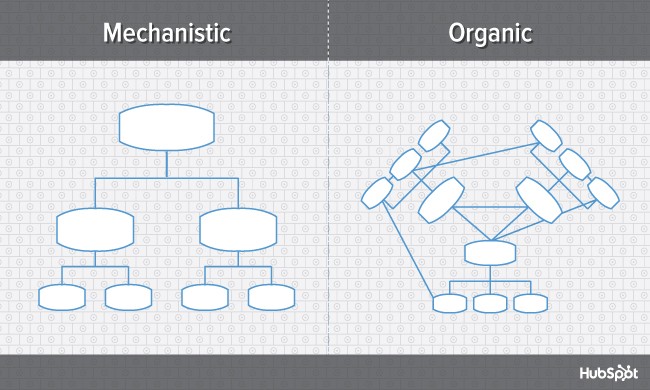
Here's a breakdown of both ends of the structural spectrum, their advantages and disadvantages, and which types of businesses are suited for them.
Mechanistic Structure
Mechanistic structures, also called bureaucratic structures, are known for having narrow spans of control, as well as high centralization, specialization, and formalization. They're also quite rigid in what specific departments are designed and permitted to do for the company.
This organizational structure is much more formal than organic structure, using specific standards and practices to govern every decision the business makes. And while this model does hold staff more accountable for their work, it can become a hindrance to the creativity and agility the organization needs to keep up with random changes in its market.
As daunting and inflexible as mechanistic structure sounds, the chain of command, whether long or short, is always clear under this model. As a company grows, it needs to make sure everyone (and every team) knows what's expected of them. Teams collaborating with other teams as needed might help get a business off the ground in its early stages, but sustaining that growth -- with more people and projects to keep track of -- will eventually require some policymaking. In other words, keep mechanistic structure in your back pocket ... you never know when you'll need it.
Organic Structure
Organic structures (also known as "flat" structures) are known for their wide spans of control, decentralization, low specialization, and loose departmentalization. What's that all mean? This model might have multiple teams answering to one person and taking on projects based on their importance and what the team is capable of -- rather than what the team is designed to do.
As you can probably tell, this organizational structure is much less formal than mechanistic, and takes a bit of an ad-hoc approach to business needs. This can sometimes make the chain of command, whether long or short, difficult to decipher. And as a result, leaders might give certain projects the green light more quickly but cause confusion in a project's division of labor.
Nonetheless, the flexibility that an organic structure allows for can be extremely helpful to a business that's navigating a fast-moving industry, or simply trying to stabilize itself after a rough quarter. It also empowers employees to try new things and develop as professionals, making the organization's workforce more powerful in the long run. Bottom line? Startups are often perfect for organic structure, since they're simply trying to gain brand recognition and get their wheels off the ground.
Now, let's uncover more specific types of organizational structures, most of which fall on the more traditional, mechanistic side of the spectrum.
Types of Organizational Structure
- Functional Organizational Structure
- Product-Based Divisional Structure
- Market-Based Divisional Structure
- Geographical Divisional Structure
- Process-Based Structure
- Matrix Structure
- Circular Structure
- Flat Structure
- Network Structure
1. Functional Organizational Structure
One of the most common types of organizational structures, the functional structure departmentalizes an organization based on common job functions.
An organization with a functional org structure, for instance, would group all of the marketers together in one department, group all of the salespeople together in a separate department, and group all of the customer service people together in a third department.
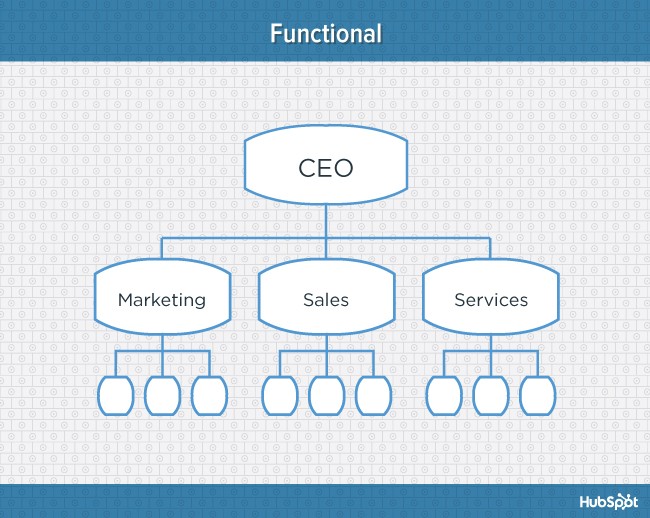
The functional structure allows for a high degree of specialization for employees, and is easily scalable should the organization grow. Also this structure is mechanistic in nature -- which has the potential to inhibit an employee's growth -- putting staff in skill-based departments can still allow them to delve deep into their field and find out what they're good at.
Disadvantages
Functional structure also has the potential to create barriers between different functions -- and it can be inefficient if the organization has a variety of different products or target markets. The barriers created between departments can also limit peoples' knowledge of and communication with other departments, especially those that depend on other departments to succeed.
2. Product-Based Divisional Structure
A divisional organizational structure is comprised of multiple, smaller functional structures (i.e. each division within a divisional structure can have its own marketing team, its own sales team, and so on). In this case -- a product-based divisional structure -- each division within the organization is dedicated to a particular product line.
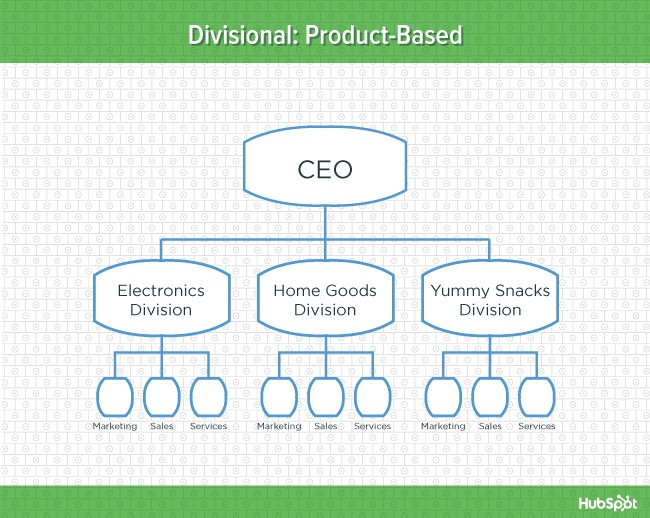
This type of structure is ideal for organizations with multiple products and can help shorten product development cycles. This allows small businesses to go to market with new offerings fast.
Disadvantages
It can be difficult to scale under a product-based divisional structure, and the organization could end up with duplicate resources as different divisions strive to develop new offerings.
3. Market-Based Divisional Structure
Another variety of the divisional organizational structure is the market-based structure, wherein the divisions of an organization are based around markets, industries, or customer types.
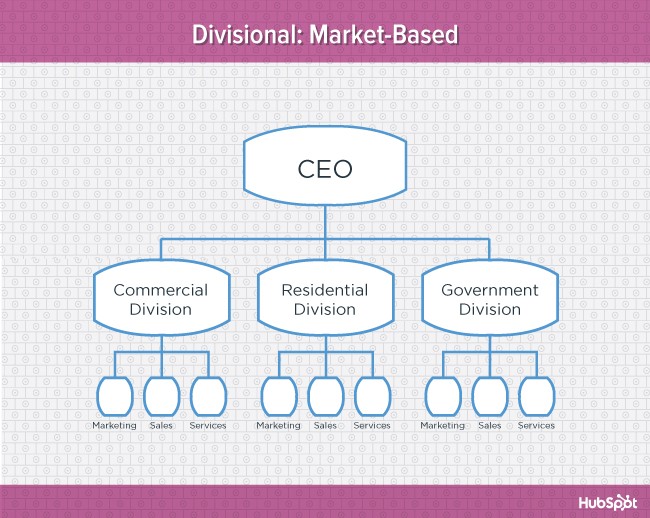
The market-based structure is ideal for an organization that has products or services that are unique to specific market segments, and is particularly effective if that organization has advanced knowledge of those segments. This organizational structure also keeps the business constantly aware of demand changes among its different audience segments.
Disadvantages
Too much autonomy within each market-based team can lead to divisions developing systems that are incompatible with one another. Divisions might also end up inadvertently duplicating activities that other divisions are already handling.
4. Geographical Divisional Structure
The geographical organizational structure establishes its divisions based on -- you guessed it -- geography. More specifically, the divisions of a geographical structure can include territories, regions, or districts.
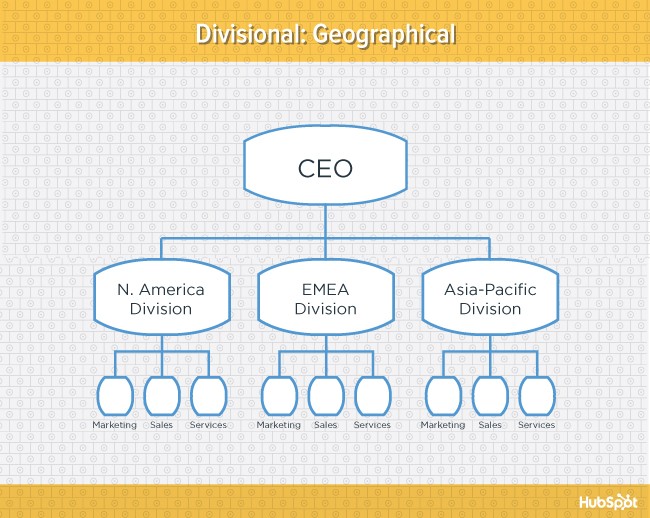
This type of structure is best-suited to organizations that need to be near sources of supply and/or customers (e.g. for deliveries or for on-site support). It also brings together many forms of business expertise, allowing each geographical division to make decisions from more diverse points of view.
Disadvantages
The main downside of a geographical org structure: It can be easy for decision- making to become decentralized, as geographic divisions (which can be hundreds, if not thousands of miles away from corporate headquarters) often have a great deal of autonomy. And when you have more than one marketing department -- one for each region -- you run the risk of creating campaigns that compete with (and weaken) other divisions across your digital channels.
5. Process-Based Structure
Process-based organizational structures are designed around the end-to-end flow of different processes, such as "Research & Development," "Customer Acquisition," and "Order Fulfillment." Unlike a strictly functional structure, a process-based structure considers not only the activities employees perform, but also how those different activities interact with one another.
In order to fully understand the diagram below, you need to look at it from left to right: The customer acquisition process can't start until you have a fully developed product to sell. By the same token, the order fulfillment process can't start until customers have been acquired and there are product orders to fill.
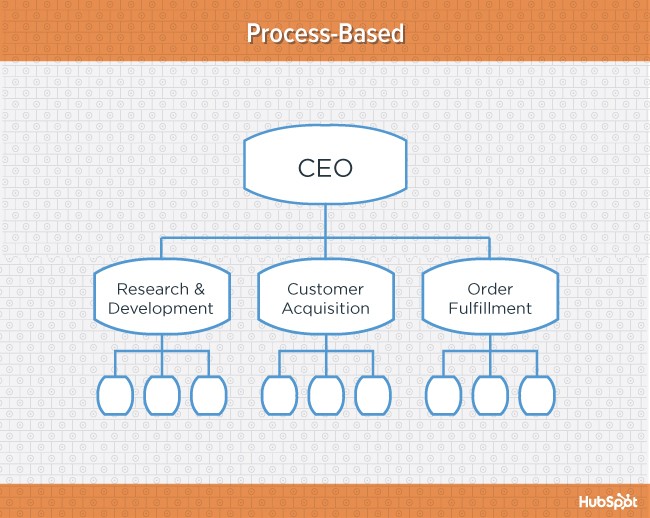
Process-based organizational structure is ideal for improving the speed and efficiency of a business, and is best-suited for those in rapidly changing industries, as it is easily adaptable.
Disadvantages
Similar to a few other structures on this list, process-based structure can erect barriers between the different process groups. This leads to problems communicating and handing off work to other teams and employees.
6. Matrix Structure
Unlike the other structures we've looked at so far, a matrix organizational structure doesn't follow the traditional, hierarchical model. Instead, all employees (represented by the green boxes) have dual reporting relationships. Typically, there is a functional reporting line (shown in blue) as well as a product- based reporting line (shown in yellow).
When looking at a matrix structure org chart, solid lines represent strong, direct-reporting relationships, whereas dotted lines indicate that the relationship is secondary, or not as strong. In our example below, it's clear that functional reporting takes precedence over product-based reporting.
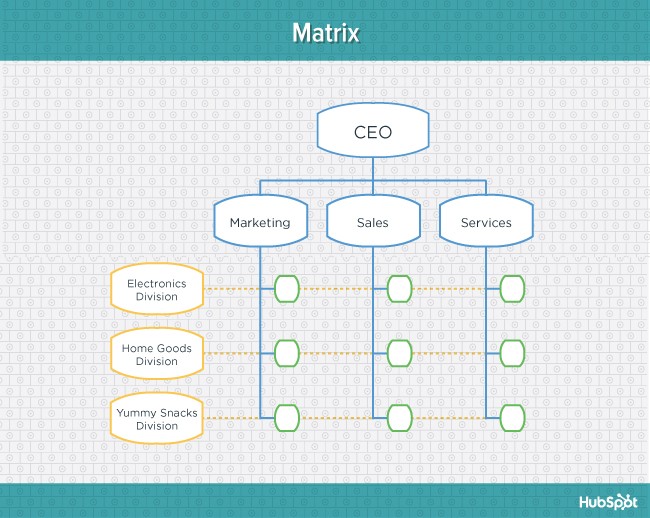
The main appeal of the matrix structure is that it can provide both flexibility and more balanced decision-making (as there are two chains of command instead of just one). Having a single project overseen by more than one business line also creates opportunities for these business lines to share resources and communicate more openly with each other -- things they might not otherwise be able to do regularly.
Disadvantages
The primary pitfall of the matrix organizational structure? Complexity. The more layers of approval employees have to go through, the more confused they can be about who they're supposed to answer to. This confusion can ultimately cause frustration over who has authority over which decisions and products -- and who's responsible for those decisions when things go wrong.
7. Circular Structure
While it might appear drastically different from the other organizational structures highlighted in this section, the circular structure still relies on hierarchy, with higher-level employees occupying the inner rings of the circle and lower-level employees occupying the outer rings.
That being said, the leaders or executives in a circular organization aren't seen as sitting atop the organization, sending directives down the chain of command. Instead, they're at the center of the organization, spreading their vision outward.

From an ideological perspective, a circular structure is meant to promote communication and the free flow of information between different parts of the organization. Whereas a traditional structure shows different departments or divisions as occupying individual, semi-autonomous branches, the circular structure depicts all divisions as being part of the same whole.
Disadvantages
From a practical perspective, the circular structure can be confusing, especially for new employees. Unlike with a more traditional, top-down structure, a circular structure can make it difficult for employees to figure out who they report to and how they're meant to fit into the organization.
8. Flat Structure
While a more traditional organizational structure might look more like a pyramid -- with multiple tiers of supervisors, managers and directors between staff and leadership, the flat structure limits the levels of management so all staff are only a few steps away from leadership. It also might not always take the form or a pyramid, or any shape for that matter. As we mentioned earlier, It's also a form of the "Organic Structure" we noted above.
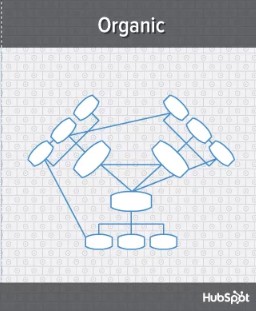 This structure is probably one of the most detailed, It's also thought that employees can be more productive in an environment where there's less hierarchy-related pressures. This structure might also make staff feel like the managers they do have are more like equals or team members rather than intimidating superiors.
This structure is probably one of the most detailed, It's also thought that employees can be more productive in an environment where there's less hierarchy-related pressures. This structure might also make staff feel like the managers they do have are more like equals or team members rather than intimidating superiors.
Disadvantages
If there's a time when teams in a flat organization disagree on something, such as a project, it can be hard to get aligned and back on track without executive decisions from a leader or manager. Because of how complicated the structure's design is, it can be tricky to determine which manager an employee should go to if they need approval or an executive decision for something. So if you do choose to have a flat organization, you should have a clearly marked tier of management or path that employers can refer to when they run into these scenarios.
9. Network Structure
A network structure is often created when one company works with another to share resources -- or if your company has multiple locations with different functions and leadership. You might also use this structure to explain your company workflows if much of your staffing or services is outsourced to freelancers or multiple other businesses.
The structure looks nearly the same as the Divisional Structure, shown above. However, instead of offices, it might list outsourced services or satellite locations outside of the office.
If your company doesn't do everything under one roof, this is a great way to show employees or stakeholders how outsourcing of off-site processes work. For example, if an employee needs help from a web developer for a blogging project and the company's web developers are outsourced, the could look at this type of chart and know which office or which person to contact outside of their own work location.
Disadvantages
The shape of the chart can vary based on how many companies or locations you're working with. If it's not kept simple and clear, there may be a lot of confusion if multiple offices or freelancers do similar things. If you do outsource or have multiple office locations, make sure your org chart clearly states where each specific role and job function lies so someone can easily understand your basic company processes.
Navigating Organizational Structures
That concludes our exploration of different types of organizational structures. Keep in mind that what we've just looked at are simply archetypes -- in real-world applications, organizations often use hybrid structures, which can borrow elements from multiple structure types.
Want to see some real-world examples of marketing team org structures from companies like GitHub and Rue La La? Download the complete resource, An Illustrated Guide to Organizational Structures.
To learn more about working on a marketing team, check out the 6 Building Blocks of Organizational Structure [Diagrams].
